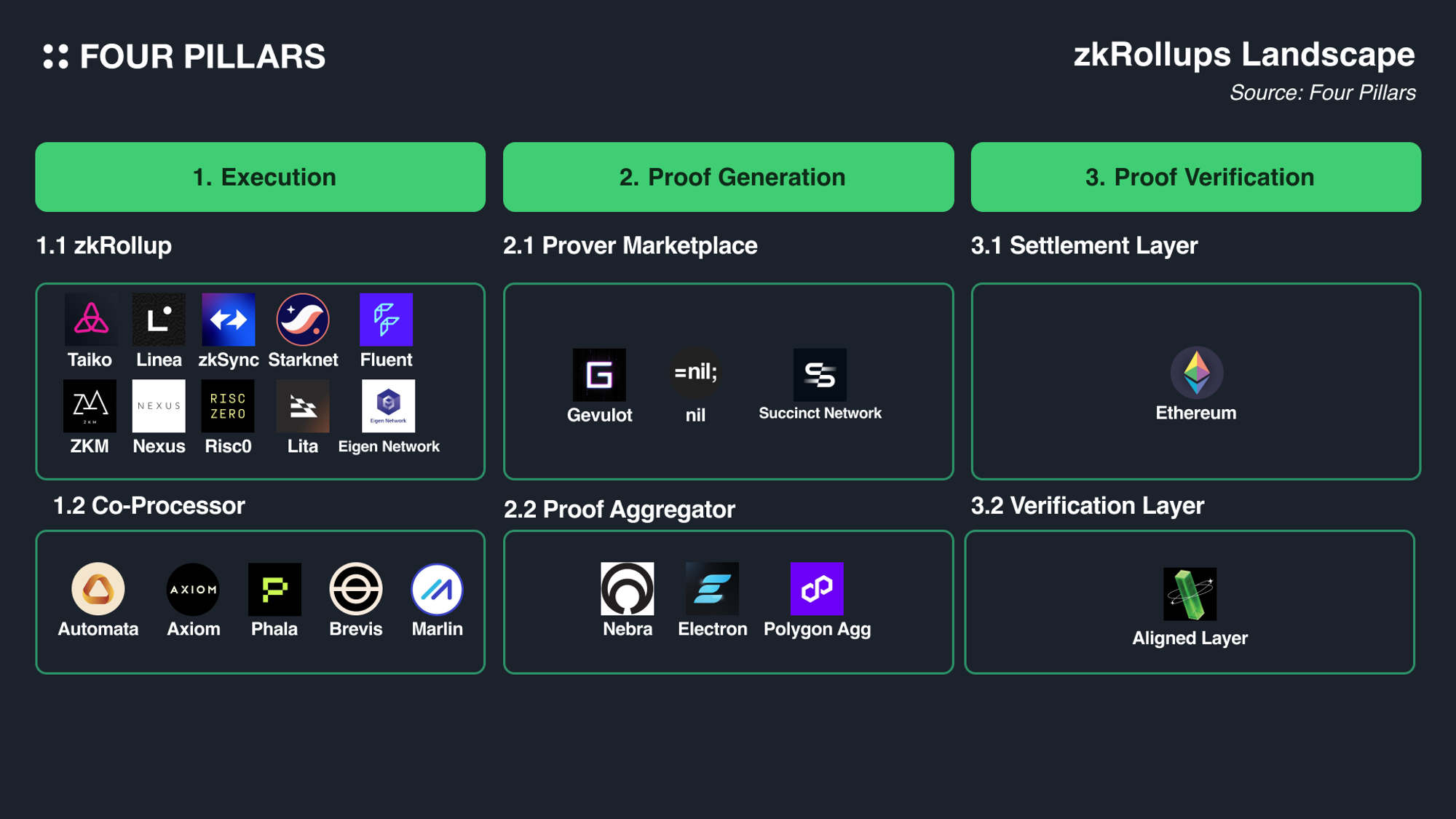What's next for zkRollups? Terms such as STARK, Co-Processor, prover marketplace, shared prover, and zk aggregating layer frequently appear in many projects. In the zkRollup ecosystem, many components are being built to make zkRollups more efficient and decentralized. Although most projects are in an early phase, as this mature, the landscape and how the zkRollup operates will change dramatically.
Let’s explore how zkRollups operate through their process - it involves three stages: execution, proof generation of the execution, and proof verification. Let’s examine this supply chain and the projects being built at each stage is modularizing this supply chain.
From a bird-eye view, lets look into the overall market landscape of zkRollups and go thorugh the process of zkRollups. zkRollups involve three main processes: execution, proof generation, and verification.

Execution: Execution in zkRollups involves processing transactions off-chain on a separate network, where they are batched and executed to update the rollup state. This category splits into zkVMs and co-processors. zkVMs, such as zkEVM, replicates the Ethereum environment that can generate the zero-knowledge proof for the execution. Co-processors use ZKPs for trustless off-chain computations, handling specific tasks like historical blockchain data queries like Axiom or running customizable computations offchain like Brevis.
Proof Generation: Proof generation in zkRollups is the process where the rollup operator creates a cryptographic proof to validate the state transitions from executed transactions. This process is resource-intensive and requires specialized computational expertise. To address these constraints, a decentralized marketplace for proof generation has emerged, exemplified by projects like Succinct Network, NIL Foundation, and Gevulot, facilitating competitive outsourcing of proof generation. Additionally, proof aggregation techniques, such as those used by Polygon AggLayer and Nebra, combine multiple proofs into a single one to reduce on-chain verification costs, enhancing efficiency across the network.
Proof Verification: Verification is the final step in the zkRollup process, where the cryptographic proofs generated are submitted to and verified by a smart contract on the main blockchain (typically Ethereum). This verification ensures the integrity of the off-chain computations without re-executing the whole state transitions. Projects like Aligned Layer enhance this process by using validators' economic security through restaking, offering modes for both fast, cheap verification and slower, fully secure verification.
The zkRollup landscape has undergone significant advancements since the mainnet launches of prominent projects in late 2023. Notable milestones include the introduction of zkSync Era in August and the launch of Polygon zkEVM in December. While these projects are still in their infancy, they have demonstrated rapid development, frequent updates, and evolving roadmaps. The zkRollup ecosystem has witnessed substantial progress across various components of its supply chain.
The execution layer has expanded beyond the conventional zkEVM approach. General zkVMs aim to support a broader range of programming languages and computational models, while zkWasm enables the use of WebAssembly in zero-knowledge proofs, potentially increasing the versatility of zkRollups. Off-chain co-processors allow for more complex computations to be performed outside the main chain, enhancing scalability. Additionally, custom zk-circuits are being developed to optimize specific operations.
As the fundamental execution and proof generation processes become more robust, efforts are now focused on enhancing the efficiency of the entire supply chain. This includes the development of decentralized marketplaces for proof generation services, techniques to combine multiple proofs to reduce overall computational overhead, and the creation of a dedicated layer for cost-effective and rapid verification of proofs.
These developments are driving zkRollups towards greater efficiency and decentralization. In the near future, we can anticipate increased modularity within the zkRollup architecture, allowing for more specialized and optimized components. Enhanced coordination between execution and proving processes will create a more cohesive ecosystem. Furthermore, the emergence of sophisticated marketplaces for various zkRollup operations will foster more decentrliazation and cost reduction.
Since zkRollup emerged later than optimistic rollups, it is true that they currently hold a smaller share of the overall rollup ecosystem. However, when considering the fundamental goals and essence of rollup technology, I believe zkRollup align better compared to optimistic rollups.
Rollups are ultimately a technical methodology developed to enhance the scalability of Layer 1, addressing scalability through cost, security, and speed aspects. Both optimistic rollups and zkRollup meet scalability requirements in terms of cost and security through their respective approaches. However, there is a significant difference in the speed aspect between the two. This difference lies in the method of filtering out incorrect or malicious rollup data, which is handled through fraud proofs in optimistic rollups and validity proofs in zkRollup. Consequently, optimistic rollups, which use fraud proofs, require a challenge period with a grace period of about a week. In contrast, zkRollup use validity proofs and do not need such a grace period, allowing transactions to be applied immediately if there is no policy-related delay within the zk-rollup service.
As someone who has personally experienced various DeFi services and especially DeFi in Layer 2 environments, the most tangible aspects are cost and speed. This is likely the same for all other users as well. Assuming the cost aspect is nearly the same, the one-week gap between optimistic rollups and zkRollup will be a significant difference in terms of user convenience. Although zkRollup currently have many areas that need improvement, such as addressing a lack of widespread adoption and building a robust community, if various technologies are enhanced based on the growing zk-rollup ecosystem, the scalability of the blockchain industry might see significant changes.
Dive into 'Narratives' that will be important in the next year